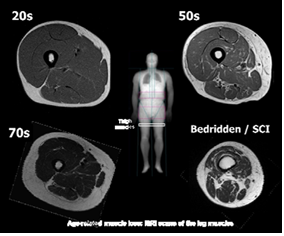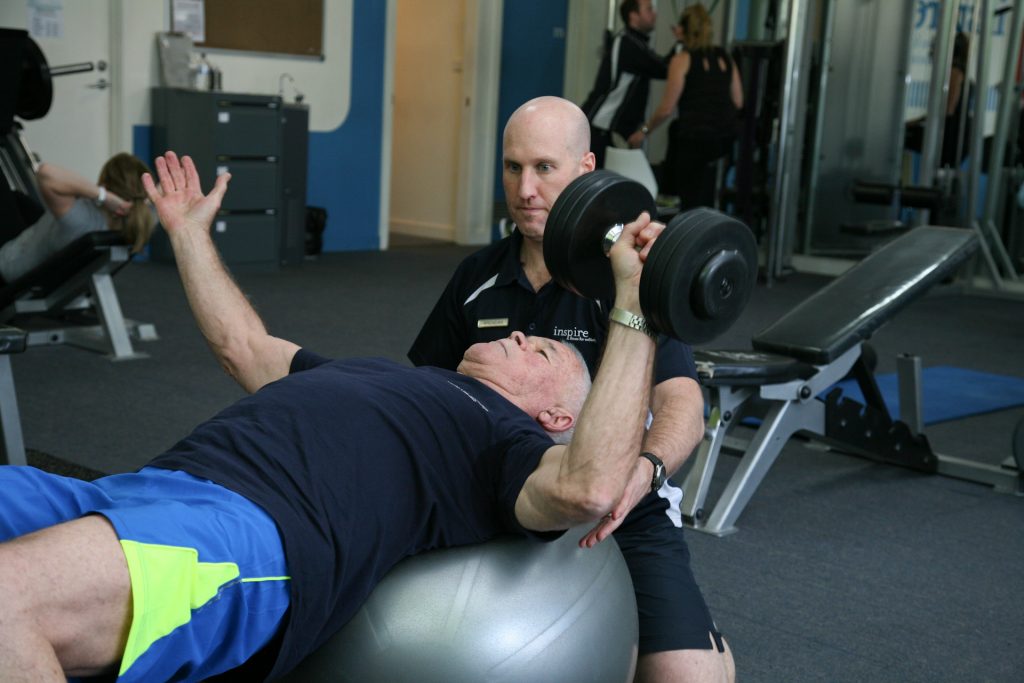One certainty in life is that everyday you will grow older. The rate of this change however occurs for each person at different rates and in different ways. This is largely determined by the lifestyle choices which YOU make every day.
Some age-related changes to your body composition and muscle function involve decreased: height, bone density, muscle mass and size, muscle strength and power, muscle contraction velocity and reduced gait speed, balance and mobility. Additionally, age related body composition changes can occur with increased weight, visceral fat mass and total body fat.
Hence, it is common (but avoidable!) that with age you will experience a reduction in your muscle mass. With lifestyle behaviors such as regular exercise (including strength training) you can dramatically slow this trend and reduce the negative health implications associated with getting older.

An MRI scan of the leg muscles (image above) comparing a 20, 50 and 70-year-old indicates age-related changes in that with age comes a reduction in the proportion of muscle and a subsequent increase in fat mass. In this image, the black represents muscle while the white represents fat.
Muscle is the largest mass of tissue in the human body and is essential for locomotion and posture, maintaining the integrity and structure of bone, reserving of energy, as well as functional roles such as the completion of every day tasks and maintaining balance.
Metabolic Double Jeopardy
These age-related changes led to the modern definition of sarcopenia, which describes a loss in muscle mass, strength and/or impaired function with age. These functional impairments lead to increases in the falls and fractures that contibute so significantly to disability and burden of disease in today’s society.
Hence, there is some suggestion that obesity is actually a direct cause for muscle loss. This metabolic double jeapordy describes that increases in fat mass (adiposity) contribute to reductions in muscle mass due to the increased release of inflammatory markers that contribute to muscle loss and other chronic diseases, including type 2 diabetes and cardiovascular conditions (4).
Inflammatory proteins and cytokines include: C-reactive protein, TNF-α and IL-6, to name a few. Adiposity creates a chronic, inflammatory environment that is associated with muscle atrophy (wasting) and the progression of sarcopenia (3).
Furthermore, TNF-α has a direct catabolic (breaking down) effect on muscle via impairing protein synthesis (2). Additionally, high IL-6 levels and low IGF-1 (promotes tissue growth) levels act in synergy to impair mobility, as IL-6 acts directly on skeletal muscle to inhibit the anabolic effects of IGF-1 (1). Hence, advancing age and adiposity contribute to musculoskeletal degenerative diseases and the development of sarcopenic obesity (4).
Sarcopenic obesity is a condition described by the presence of both obesity and sarcopenia, in which high levels of adiposity contribute further to loss of muscle mass due to the release of inflammatory cytokines, as outlined above. It is recommended that regular exercise coupled with a healthy diet is the most effective way to counteract sarcopenic obesity in order to maintain and improve mobility and function as you age (4).

At Inspire Fitness for Wellbeing our team work with an array of ageing adults in order to prevent and manage the age-related changes outlined in this article. We do this through the design of a tailored individualized exercise program to suit the specific needs of each of our valued members.
For more information please contact us on 9857 3007 to speak to one of our Exercise Physiologists or Personal Trainers.
